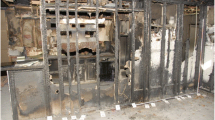Abstract
Of primary concern in structural fires is the ability of occupants to escape once a fire has been detected. This paper describes a technique for calculating the number of directed routes from any room to a location of safety.
Similar content being viewed by others
References
Birky, Merritt M., “Hazard Characteristics of Combustion Products in Fires: The State-of-the-Art Review,” National Bureau of Standards, Washington, DC, July 1977.
Friedman, Raymond, “Quantification of Threat from a Rapidly Growing Fire, In Terms of Relative Material Properties,” Factory Mutual Research Corporation, Norwood, MA, June 1977.
Henderson, L. F., “The Statistics of Crowd Fluids,”Nature, 1971.
Melinek, S. J., and Booth, S., “An Analysis of Evacuation of Buildings: Some Effects of Changes in Performance Standards,” Fire Research Station, Borham Wood, UK, October 1975.
National Fire Protection Association, “Interim Technical Report — Fire Safety Systems Analysis for Residential Occupancies,” Boston, MA, March 1977.
National Fire Protection Association, “The Beverly Hills Supper Club Fire, Southgage, Kentucky,” May 28, 1977, Boston, MA.
Stall, F., “Simulating Human Behavior in High-Rise Building Fires: An Illustrative Case and Validation Study,” The City University of New York, NY, July 1975.
Stall, F., and Archea, J., “An Assessment of the Technical Literature on Emergency Egress from Buildings,” National Bureau of Standards, Washington, DC, October 1977.
Author information
Authors and Affiliations
Additional information
Note: The model discussed here was developed as part of a project to study fire-safety in residential occupancies being funded by the U.S. Department of Housing and Urban Development (Project H-2316).
Rights and permissions
About this article
Cite this article
Berlin, G.N. The use of directed routes for assessing escape potential. Fire Technol 14, 126–135 (1978). https://doi.org/10.1007/BF02308907
Issue Date:
DOI: https://doi.org/10.1007/BF02308907




